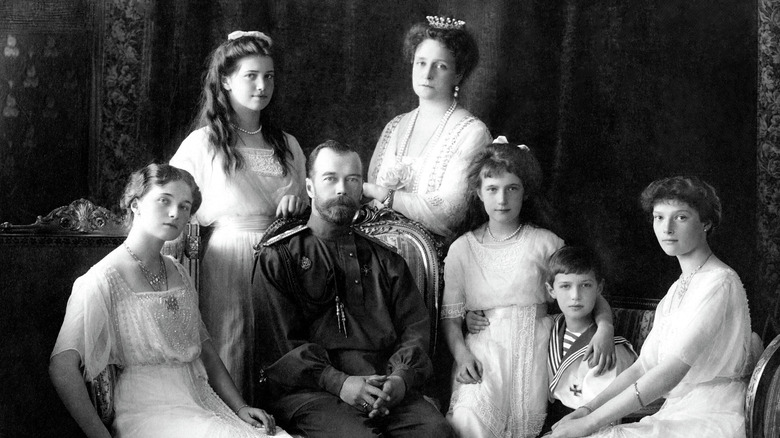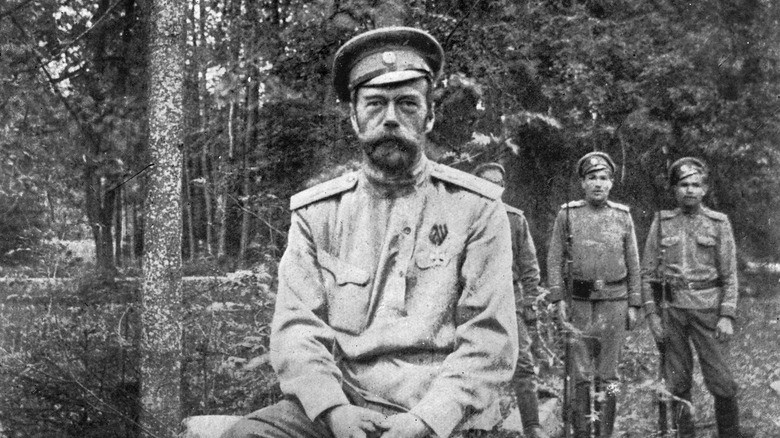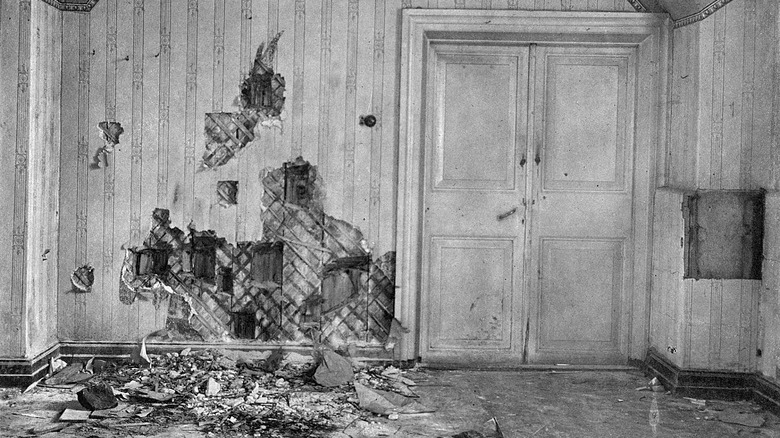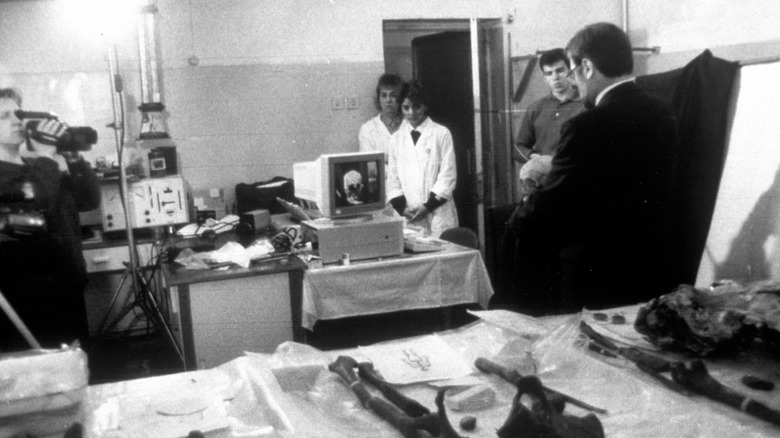The Truth About The Mystery Of The Russian Romanovs
For three centuries, the House of Romanov were boyars, Russia's highest-ranking aristocrats. They ruled between 1613 until the death of the last Romanovs in 1917. For 300 years, the Romanov had been plagued by scandal, reforms, and revolutions (via History).
When Nikolai II took the throne as the last czar of Russia in 1894 and married Alexandra Feodorovna, he also brought additional trouble to the House of Romanov. Alexandra was the grandchild of England's Queen Victoria, and as many other members of the royal family, she was a carrier of the hemophilia gene. The couple had four children: three daughters and one son, heir Alexei Nikolaevich, Tsarevich of Russia. Alexei inherited the hemophilia gene from his mother and was a very sick child who suffered from serious bleeding episodes (per Nature).
Alexandra's desperation was understandable, as the royal physicians were unable to help, and it seemed likely Alexei wouldn't make it much longer. In her search for a cure, she ended up bringing mystic monk Grigori Rasputin into the court as a healer. Rasputin had a scandalous past and was considered a charlatan by many, and the Romanov family's reputation suffered greatly by associating with him, according to History.
In addition, Nicholai II was considered politically weak, often making erratic decisions and lacking diplomatic expertise. According to History, he made poor choices during the Russo-Japanese War of 1904-1905 and then again during WWI — all of which angered both royals and peasants alike.
Nicholai II tried to redeem the House of Romanov by heading to the warfront
It was 1915 and this was a final attempt to keep the dynasty's authority alive. Back home, riots and rebellions were increasing due to lack of food and supplies and the high death toll of WWI. The threat of revolution was becoming a reality. In March 1917, Bolshevik revolutionaries forced Nicholai to abdicate, effectively leading to the collapse of the Russian monarchy (per History).
When offers of exile to Great Britain fell through, the family was forced into house arrest at Alexander Palace at Tsarskoye Selo, a town just 15 miles south of St. Petersburg. While life inside the palace was fairly normal for the Romanov, guards followed the royals when they went out for walks, as reported by Saint-Petersburg.com.
By August 2017, the provisional government was afraid that the unstable political situation in the main cities could get violent and decided to move the imperial family farther away for their own safety. The Romanovs were then taken to the Governor's Palace in the very small Siberian town of Tobolsk. Forty-six court attendants, including servants, joined the five-day train trip to the family's new residence (per The Atlantic).
The Romanovs enjoyed a fairly relaxed, almost happy life at the palace until April of the following year, when orders came that they had to move again. According to The Atlantic, the family and servants then headed for their new and final residence in Yekaterinburg.
Darker times were ahead for the family
Life was very different at the Ipatiev house, a simple merchant's house that was a far cry from the luxury the imperial family was used to. Alexei was often ill, and the Romanov daughters endured disrespectful behavior from the guards on a regular basis (via The Atlantic).
Except for short walks in the garden, the Romanovs spent most of their time in five small rooms on the second floor of the house. By the beginning of July, the usual guards were replaced by men from the Chrezvychaika or "Cheka" secret police. A few days later, they would be given the "go ahead" from Moscow to kill the entire family (per History Today).
Just after midnight on July 17, 1918, the family was woken up and taken to a room in the basement under the excuse that revolutionaries were approaching, and the family would be safer downstairs. The family's physician, cook, a chambermaid, and a footman joined the family in the basement. After some time, secret police commander Yakov Yurovsky walked into the room, announced the family had been sentenced to death, and shot the Tsar (via History).
While Nicholai II died instantly, the rest of the family did not. Yurovsky's guards then opened fire, filling the room with smoke and causing them to miss their targets. As reported by The Atlantic, some of the victims were shot several times and others were bayoneted to death, stabbed or attacked with the butts of the guns. It took over 20 minutes before everybody was dead.
Getting rid of the bodies proved a difficult task as well
It took several tries (which included a mine shaft, grenades, and acid) before Yurovsky and his men finally dug a shallow grave and threw most of the bodies in. The remains of two of the children were burned and buried somewhere else. While the Bolsheviks (revolutionary party) soon took credit for killing Nicholai II, the murder of the imperial family remained a well-guarded secret for decades, according to History.
It wasn't until 1979 that the mass grave was found, though things remained quiet until an investigation was launched in 1991. Once DNA confirmed the remains belonged to the Romanovs, the family (except for the two missing children) was buried in St. Petersburg cathedral and were soon after declared saints in the Russian Orthodox church. But according to History, things weren't so simple for the other two children, who were suspected to be Alexei and either Maria or Anastasia.
For starters, their bodies weren't found until 2007, and despite DNA analysis proving their lineage, the Russian Orthodox Church refused to acknowledge the findings. New DNA tests confirmed the findings in 2015 (when Tsar Nicholai II's body was exhumed for DNA comparison) and 2018, but the church still insisted "more proof was needed."
According to reports published on Smithsonian Magazine, the church claimed they needed to be extra careful in confirming the identity of the children, as their bones are considered relics (sacred) because of the family's canonization. The truth, however, is possibly a lot more political than religious.
After 100 years, peace still escapes the Romanovs
The grave containing the remains of the two children was located in 2007, not far from the main burial site, but the bodies had been burned almost completely to ash (via DW). While it's true that fewer than 50 bone fragments were found, DNA tests are conclusive: They belong to members of the Romanov family.
The bodies of Alexei and (likely) Maria have never been buried. They remain in hold at a Russian state archive because the church demands more proof that it is really them. According to Archpriest Oleg Mitrov, "the search for the remains of Tsesarevich Alexei and Grand Duchess Maria should continue," as quoted by TsarNicholas.org.
Conspiracy theories could have come into play, too. For years, there was speculation that the two missing children hadn't been found because they had somehow escaped and were still alive somewhere. History reports that between 1918 and 1928, half a dozen women publicly claimed to be the missing Romanov daughter. The most famous case was the story of Anastasia Tschaikovsky, also known as Anna Anderson, who claimed to be the missing Anastasia.
Anderson had spent some time in a mental hospital after a suicide attempt, and was eventually helped by Romanov sympathizers to escape to the U.S. There, she engaged in a long legal battle to be recognized as Anastasia Romanov. She eventually lost her court battle and died in 1984. According to History, a DNA test performed a decade later proved Anderson was definitely not a Romanov.




